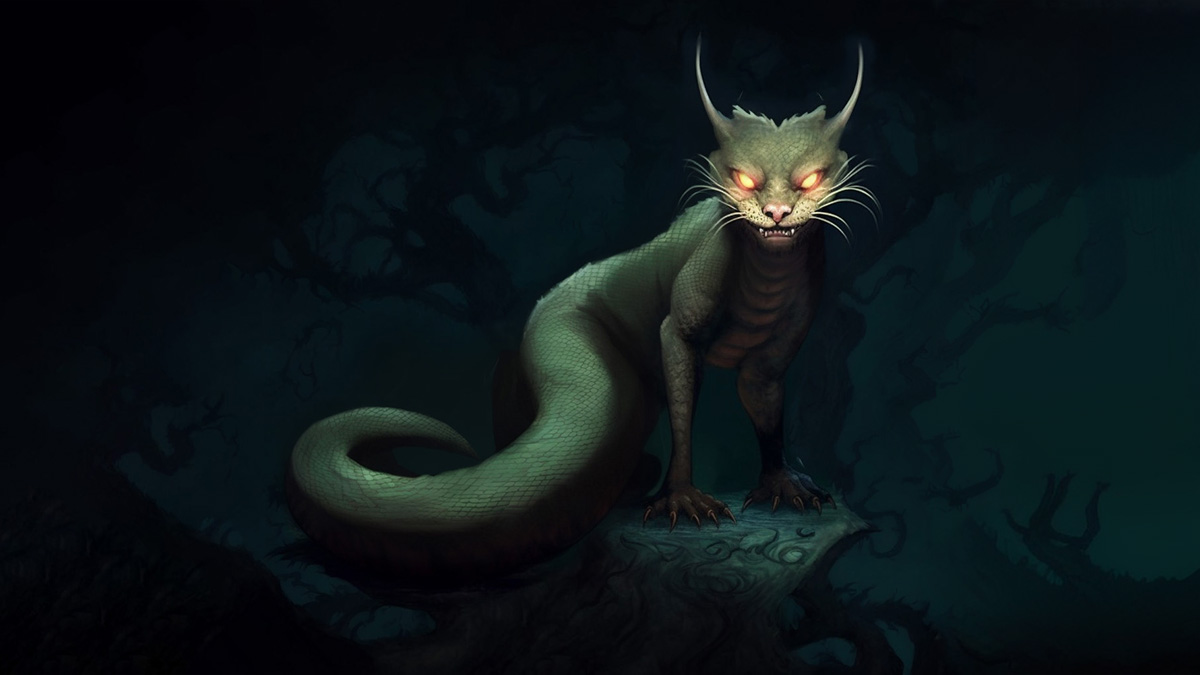The Tatzelwurm is said to be a small, carnivorous, lizard-like creature with the head of a cat and a serpent’s body living in the lower elevations of the Alps of Austria and Switzerland.
Description
The legend of the Tatzelwurm (claw worm) has been around for hundreds of years.
Scientists are split on what it might be, with some suggesting it may be some kind of amphibian – perhaps an unknown European relative of Megalobatrachus, which is a Giant Salamander found in China and Japan.
Descriptions of the creature vary, but it is generally described as a stumpy-legged, lizard-like, or dragon-like animal measuring between 2 and 6 feet long. The number of legs ranges between two and six, but the creature is consistently described as having sharp claws.
The Tatzelwurm’s cat-like head is very distinctive, although it has scales in place of fur, and it has huge eyes.
This cryptid is thought to be aggressive if it is threatened. It will sometimes run off when it sees a person, but they have been said to attack people and try to bite them.
The Tatzelwurm is believed to hibernate during the winter, becoming active again in the spring.
It is feasible that the Tatzelwurm could be a type of salamander. Salamanders do live in mountainous regions, so it is not beyond the bounds of credulity. Also, some salamanders have very atrophied legs, meaning a particular species of salamander could have evolved to thrive in the Alps.
Certain species of salamander are only glimpsed on rare occasions, meaning they have almost attained legendary status. Could an unknown species be out there?
Sightings and Tales
For hundreds of years, there have been tales of dragons or giant worm-like creatures being sighted in the Alps. As far back as the 13th century, pilgrims in the Bavarian Alps journeying to the chapel at Birkenstein (modern Germany) reported attacks from a monstrous creature. Part of the route across the mountains was even called Zum Datzelwurm, which is another word for Tatzelwurm.
The 17th century began to see images of strange cat-faced creatures attacking people. But it was the 18th century before the legend of a Tatzelwurm really began to take hold in these mountainous regions.
One of the earliest recorded accounts of a Tatzelwurm sighting is from 1779. One of the creatures allegedly ambushed a pig that belonged to a farmer named Hans Fuchs.
Hearing the pig in distress, Hans rushed out to see what was happening, only to be confronted by the Tatzelwurm. He was so terrified that he suffered what was to prove a fatal heart attack as he ran home.
Before he died, Hans managed to tell his family what he had seen. One of his relatives produced a painting of the creature after Hans’ death; the painting shows the lizard-like animal lurking in the foreground.
Two further illustrations of the Tatzelwurm are known to exist. The first of these appeared in a Bavarian hunting manual called New Pocket Guild of the Year 1836 for Nature, Forest, and Hunting Enthusiasts and shows a scaly, cigar-shaped creature with stumpy legs.
The second illustration appeared in a Swiss almanac – Alpenrosen – published in 1841. This drawing shows a long, scaly animal with two small front legs.
Kaspar Arnold claimed to have seen a Tatzelwurm while sitting in a restaurant in Tirol, Austria. This was in 1883 or 1884, but we cannot be sure. He says he watched the two-legged creature for approximately 20 minutes.
In 1921, two witnesses say they were attacked by a Tatzelwurm near Salzburg, Austria. They said the creature jumped 9 feet into the air and that it was about 3 feet long with the head of a cat.
A Swiss photographer called Balkin claimed to have photographed a Tatzelwurm in 1934. The photo generated a great deal of interest at the time, but it is now thought to have been a hoax.
Interestingly, a skeleton was thought to have been mysteriously donated to the Geneva Institute of Science. The skeleton has not been found, and there is only one photo of it, which shows a long snake-like creature with two short, clawed arms and a somewhat large head.
Many believe the story to be false and that the skeleton did not exist, and no one has any idea who the mystery donor could have been.
A flurry of sightings were reported in the Tresivio area of Italy – on the Swiss border – in 2009. The authorities attributed most of these reports to the fact that a number of monitor lizards had escaped from their owners, but there is no conclusive evidence either way.
Reports have dried up in recent years, leading to speculation that the Tatzelwurm – if it ever existed – may now be extinct.
| Other Name/s | Stollenwurm, Bergstutzen, Springwurm |
| Location | Austria, Germany, Italy, Switzerland, |
| Type | Monster |
| Habitat | Mountains |
References
unknownexplorers.com, “Tatzelwurm,” accessed October 10, 2017,
newanimal.org, “The Cryptid Zoo: Tatzelwurm (Swiss Dragon),” accessed October 10, 2017,
phantomsandmonsters.com, “Tatzelwurm: Dragon of the Alps,” accessed October 10, 2017,
https://www.sagen.at/texte/sagen/deutschland/bayern/inntal/tatzelwurm.html, “The fiery Tatzelwurm in the Gumpei Gorge,” accessed March 9, 2023.
